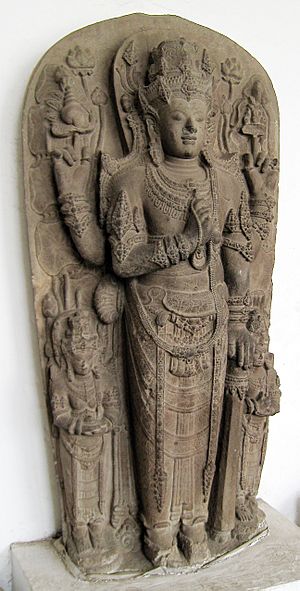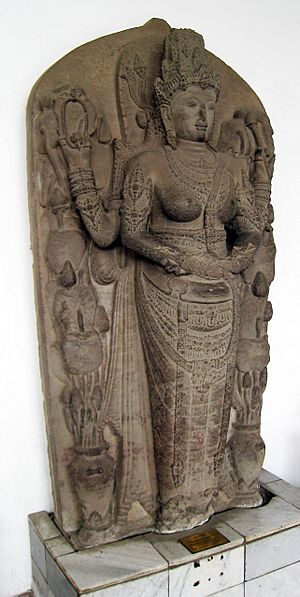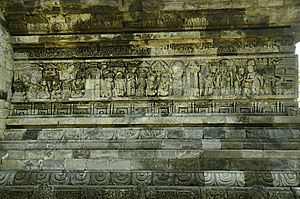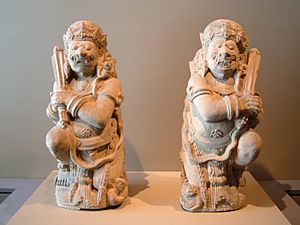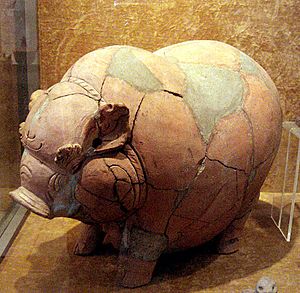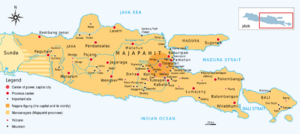Majapahit facts for kids
Quick facts for kids
Majapahit Empire
|
|||||||||
|---|---|---|---|---|---|---|---|---|---|
| 1293–1527 | |||||||||
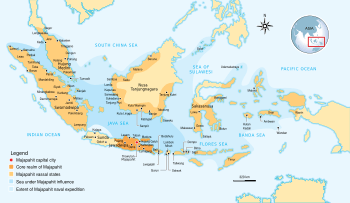
The greatest extent of Majapahit influence based on the Nagarakretagama in 1365
|
|||||||||
| Capital | Majapahit (sometimes referred to by its Sanskrit name, Wilwatikta) (modern Trowulan), Daha (modern Kediri) | ||||||||
| Common languages | Old Javanese (main), Sanskrit (religious) | ||||||||
| Religion | Hinduism, Buddhism, Kejawen, Animism | ||||||||
| Government | Absolute monarchy | ||||||||
| Maharaja (emperor/empress) | |||||||||
|
• 1293–1309
|
Raden Wijaya | ||||||||
|
• 1309–1328
|
Jayanegara | ||||||||
|
• 1328–1350
|
Tribhuwana Wijayatunggadewi | ||||||||
| History | |||||||||
|
• Coronation
|
10 November 1293 | ||||||||
|
• Demak takeover
|
1527 | ||||||||
| Currency | Native gold and silver coins, Kepeng (copper coins imported from China and later produced locally) | ||||||||
|
|||||||||
The Majapahit Empire was a powerful kingdom in Southeast Asia. It was based on the island of Java in what is now Indonesia. This Hindu-Buddhist empire existed from 1293 to about 1527.
Majapahit reached its greatest power under King Hayam Wuruk (1350–1389). His prime minister, Gajah Mada, helped him conquer many lands. According to an old poem called Nagarakretagama, Majapahit ruled over 98 areas. These stretched from Sumatra to New Guinea. This included parts of modern-day Indonesia, Singapore, Malaysia, Brunei, southern Thailand, East Timor, and the southwestern Philippines.
Majapahit was one of the last big Hindu empires in the region. It is seen as one of the greatest and most powerful empires in Indonesian history. Some even see it as a model for Indonesia's modern borders.
Contents
- What Does "Majapahit" Mean?
- How Do We Know About Majapahit?
- The Story of Majapahit
- Majapahit's Military Might
- Exploring the World
- Majapahit Culture and Art
- Majapahit's Economy
- How Majapahit Was Governed
- Majapahit's Relationships with Neighbors
- Majapahit's Lasting Legacy
- Who Ruled Majapahit?
- Images for kids
- See also
What Does "Majapahit" Mean?
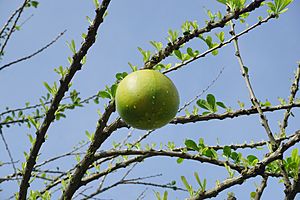
The name Majapahit comes from the Javanese language. It means "bitter maja". Maja is the name of a fruit from a tree found in Indonesia.
The name first referred to the area around Trowulan. This was where the Majapahit kingdom began. Workers clearing land found maja trees and tasted their bitter fruit. So, they named the village Majapahit. In ancient Java, kingdoms were often named after their capital city. Majapahit was also known as Wilwatikta in Sanskrit.
How Do We Know About Majapahit?
Not much physical evidence of Majapahit remains today. However, people in Java never completely forgot about it. Old Javanese stories mention Mojopait.
The main ruins from the Majapahit period are in the Trowulan area. This was the royal capital. An English governor, Stamford Raffles, first wrote about these ruins in the 1800s. He called Trowulan "this pride of Java."
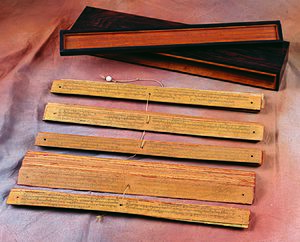
Historians learned about Majapahit from old Javanese and Balinese writings. Two important sources are the Pararaton (Book of Kings) and the Nagarakretagama. The Pararaton tells about the start of Majapahit. The Nagarakretagama is a long poem written in 1365. It describes Majapahit during its golden age under King Hayam Wuruk.
Chinese historical records also tell us about Majapahit. The Chinese admiral Zheng He visited Majapahit between 1405 and 1432. His translator, Ma Huan, wrote a detailed description of Java. This book, Yingya Shenglan, gives us valuable information about Majapahit's culture and economy.
Archaeologists are still studying the Trowulan area. They have found old canals and artifacts. This suggests the Majapahit capital was much larger than once thought.
The Story of Majapahit
How Majapahit Started
In 1290, the Singhasari kingdom in Java became very powerful. The Mongol emperor, Kublai Khan of China, demanded tribute from Singhasari. King Kertanegara of Singhasari refused and insulted the Mongol envoy. In response, Kublai Khan sent a huge fleet of 1000 ships to Java in 1293.
The Mongol Invasion and a Clever Plan
At this time, a duke named Jayakatwang had taken over Singhasari and killed King Kertanegara. Kertanegara's son-in-law, Raden Wijaya, was given land in the Tarik forest. He cleared the land and built a new village called Majapahit.
When the Mongol army arrived, Wijaya pretended to be their ally. He joined them to fight against Jayakatwang. After Jayakatwang was defeated, Raden Wijaya launched a surprise attack on the Mongol army. The Mongols were confused and had to leave Java quickly. They needed to catch the monsoon winds to sail home.
The First King of Majapahit
In 1293, Raden Wijaya founded the Majapahit kingdom. He was crowned on November 10, 1293, and took the name Kertarajasa Jayawardhana. King Kertarajasa married all four daughters of the former King Kertanegara. He also married a princess from Sumatra.
The new kingdom faced problems. Some of Kertarajasa's trusted friends rebelled against him. It was thought that a minister named Mahapati Halayudha caused these rebellions. He wanted to get rid of his rivals. But his tricks were found out, and he was put to death. King Wijaya died in 1309.
Jayanegara's Difficult Rule
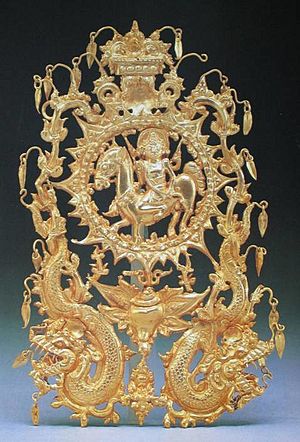
Wijaya's son, Jayanegara, became the next king (1309–1328). His rule was difficult and full of rebellions. The most dangerous was the Kuti rebellion in 1319. Kuti took control of the capital city.
King Jayanegara barely escaped with the help of Gajah Mada and his royal guards. Gajah Mada then returned to the capital. He found that the people and nobles did not support Kuti. So, Gajah Mada gathered forces and crushed the rebellion. Jayanegara returned to his throne. Gajah Mada was rewarded with a high position for his loyalty.
Jayanegara was known for his bad behavior. He wanted to marry his half-sisters, which was against Javanese tradition. In 1328, his doctor, Tanca, murdered him during surgery. Gajah Mada immediately killed Tanca. Some say Gajah Mada planned the murder to get rid of a bad king. Since Jayanegara had no children, there was no clear successor.
Majapahit's Golden Age
Queen Tribhuwana's Reign
Jayanegara's stepmother, Gayatri Rajapatni, was supposed to rule. But she had become a Buddhist nun. So, she appointed her daughter, Tribhuwana Wijayatunggadewi, as queen (1328–1350).
Queen Tribhuwana made Gajah Mada her Prime Minister in 1336. At his inauguration, Gajah Mada made a famous promise called the Palapa oath. He swore not to eat spicy food until he had united the entire Indonesian archipelago under Majapahit.
Under Gajah Mada's leadership, Majapahit grew much larger. In 1342, Majapahit forces conquered the island of Bali. They defeated the Balinese king in 1343. Majapahit then placed its own rulers in Bali. Queen Tribhuwana ruled until her mother died in 1350. She then gave the throne to her son, Hayam Wuruk.
Hayam Wuruk and Gajah Mada's Conquests
Hayam Wuruk ruled Majapahit from 1350 to 1389. This was Majapahit's golden age. With Gajah Mada's help, Majapahit conquered many more territories. It became the most powerful kingdom in the region.
The Nagarakretagama poem lists many states under Majapahit's power. These included parts of Sumatra, the Malay Peninsula, Borneo, Sulawesi, and other islands. In 1350, Majapahit sent a large navy to attack the Samudera Pasai Sultanate in Sumatra. This expansion made Majapahit one of the most influential empires in Indonesian history. It was a major trading empire in Asia.
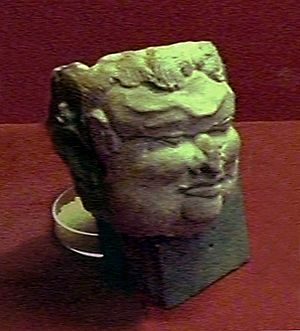
Majapahit also used diplomacy. King Hayam Wuruk wanted to marry Princess Dyah Pitaloka Citraresmi of the neighboring Sunda Kingdom. The Sundanese saw this as an alliance. In 1357, the Sunda king and his family came to Majapahit for the wedding.
However, Gajah Mada saw this as a chance to force Sunda to submit to Majapahit. A fight broke out between the Sunda royal family and Majapahit troops. Almost all the Sundanese royal party were killed. This sad event is known as the Battle of Bubat.
The Nagarakretagama describes Majapahit as a rich kingdom with advanced art and literature. It was the center of a huge "mandala" (sphere of influence). Majapahit's direct rule was mainly in East Java and Bali. But it demanded loyalty from many other islands.
Around the time Majapahit was founded, Muslim traders began arriving. An old Muslim cemetery was found in Trowulan, the capital. This shows that Muslim traders lived in the capital as early as the mid-1300s.
Majapahit's Decline
After Hayam Wuruk died in 1389, Majapahit's power began to fade. There was a fight over who would be the next ruler. Hayam Wuruk's daughter, Kusumawardhani, married Prince Wikramawardhana. But Hayam Wuruk also had a son, Wirabhumi, who claimed the throne.
By this time, Majapahit had lost control over its lands in northern Sumatra and the Malay Peninsula. The Kingdom of Singapura was sacked by Majapahit in 1398. Its last king fled to the Malay Peninsula and founded the Melaka Sultanate in 1400.
The Regreg War
A civil war called the Regreg War happened from 1405 to 1406. It was a fight between Wikramawardhana and Wirabhumi. Wikramawardhana won, and Wirabhumi was killed. But this war used up a lot of money and weakened Majapahit's control over its distant lands.
Chinese Visits and New Powers

During Wikramawardhana's rule, Chinese naval expeditions led by Admiral Zheng He visited Java several times (1405–1433). These voyages showed China's power. China supported the new Sultanate of Malacca. Malacca became a rival to Majapahit.
The Chinese also helped establish Muslim communities in northern Java. This led to Islam gaining a strong presence on Java's coast. Malacca grew strong under Chinese protection. Majapahit's influence in Sumatra weakened.
Queen Suhita and Later Kings
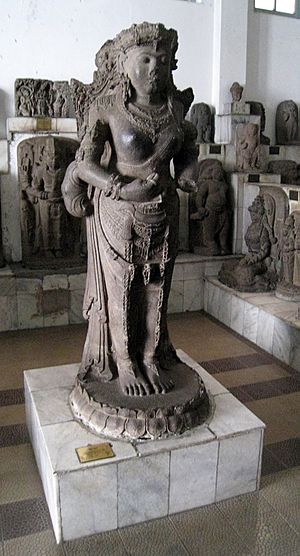
Wikramawardhana ruled until 1429. His daughter, Suhita, became queen (1429–1447). Her reign is remembered in the Javanese legend of Damarwulan.
After Suhita died, several kings ruled for short periods. There was even a three-year period without a king.
The Kingdom Splits Apart
In 1468, Prince Kertabhumi rebelled. He declared himself king of Majapahit. The old king, Singhawikramawardhana, moved the capital inland to Daha. This split Majapahit into two parts: Kertabhumi in Trowulan and Singhawikramawardhana in Daha.
Kertabhumi tried to stabilize the kingdom by working with Muslim merchants. He gave them trading rights on Java's north coast. This helped Majapahit's money but also helped Islam spread faster.
The Fall of Majapahit
The end of the Majapahit Empire is usually set around 1478 or 1527. In 1478, the army of Ranawijaya (from Daha) attacked Trowulan and killed Kertabhumi. This was a major blow, but not the complete end of Majapahit. Ranawijaya ruled from Daha until 1498.
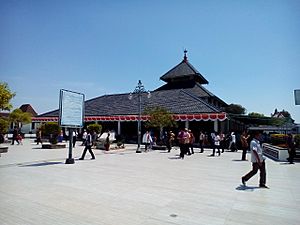
The Demak Sultanate, a rising Muslim power on Java's north coast, became very strong. Demak was a former Majapahit vassal. In 1527, Demak finally conquered Daha. This marked the end of the Majapahit kingdom.
Many Majapahit nobles, artists, and priests fled to the island of Bali. They wanted to avoid Demak's rule. Demak became the first Islamic sultanate in Java. Hindu kingdoms in Java were then only in Blambangan (east) and Pajajaran (west). Over time, Hindu communities moved to the mountains or to Bali.
Majapahit's Military Might
Early Majapahit soldiers were mostly farmers with simple weapons like bows, bamboo spears, and short blades. Noble warriors used swords and spears.
Gunpowder technology came to Java during the Mongol invasion in 1293. Majapahit, under Gajah Mada, used gunpowder in its navy. Later, Majapahit began making its own cannons called cetbang. These early cannons looked like Chinese ones. They fired arrow-like projectiles or round bullets.
Around 1460, new types of gunpowder weapons arrived from West Asia. These were breech-loading swivel guns. Majapahit made a new type of cetbang based on these. These cannons were used against people on enemy ships, not to sink ships.
Majapahit also had elite troops called Bhayangkara. Their main job was to protect the king and nobles. They wore armor like chain mail or metal plates on their chests.
Majapahit also used firearms. By the early 1500s, Javanese soldiers were using long muskets called arquebus. One account from around 1500 describes Majapahit troops "shooting their firearms."
The Majapahit army also had cavalry (soldiers on horses). Java was known for breeding horses. In 1513, a Portuguese visitor noted the Javanese lords had richly decorated horses with gold stirrups.
The main warship of the Majapahit navy was the jong. These were large transport ships. They could carry 100 to 2000 tons of cargo and 50 to 1000 people. Some jongs were over 88 meters long. When Majapahit attacked Pasai, they used about 400 jongs.
Exploring the World
Majapahit people were skilled navigators. They used natural signs and "star path navigation" to find their way at sea. They also used compasses and maps. In 1293, Raden Wijaya gave a map to the Mongol invaders. This shows that mapmaking was important in Java.
When the Portuguese conquered Malacca in 1511, they found a map from a Javanese pilot. This map even included parts of the Americas! The Portuguese leader, Afonso de Albuquerque, said it was the best map he had ever seen.
Majapahit Culture and Art
Daily Life and Customs
The capital, Trowulan, was a grand city known for its yearly festivals. People practiced Buddhism, Shaivism (a type of Hinduism), and Vaishnavism (another type of Hinduism). The king was seen as an incarnation of these gods.
An Italian friar named Odoric of Pordenone visited Java between 1318 and 1330. He said the king of Java ruled over seven other kings. He noted that Java had many spices like cloves and nutmeg. He also described the king's palace as grand and luxurious, with stairs and interiors covered in gold and silver.
Ma Huan, Zheng He's translator, visited Majapahit in 1413. He described the king wearing a gold crown and embroidered silk. He rode an elephant or an ox-drawn carriage.
Common people wore simple clothes. Men and boys carried daggers called pu-la-t'ou (likely kris daggers). These daggers were made of steel with beautiful carvings. Their handles were made of gold, rhino horn, or ivory.
People ate rice with their hands. They chewed betel nut with leaves and chalk. When guests arrived, they offered betel nut instead of tea.
Ma Huan also described traveling musical groups. People would sing and chant, and families would give them gifts. He also saw artists who drew pictures on rolled paper screens and told stories. This art form is called wayang bébér, which still exists in Java today.
Literature and Stories
Majapahit had a rich tradition of literature. Poets wrote long poems called kakawin. Famous works include Prapanca's Nagarakretagama and Tantular's Sutasoma.
The Indonesian national motto, "Bhinneka Tunggal Ika" (Unity in Diversity), comes from the Sutasoma poem. It means "It is diverse, yet it is one." The poem originally promoted religious tolerance between Hindus and Buddhists.
Ma Huan noted that Javanese people wrote on palm leaves using a sharp knife. They had a well-developed language and grammar.
Art and Architecture
Majapahit art continued the style of East Javanese art. Statues were often stiff and formal, unlike earlier, more relaxed styles. This style is still seen in Balinese art today.
Clay pottery and brick buildings were common in Majapahit. Many terracotta items were found in Trowulan. These include human and animal figures, jars, and even piggy banks shaped like boars. The Indonesian word for piggy bank, celengan, comes from celeng, meaning "wild boar."
Ma Huan described Majapahit cities without walls. The king's palace had thick red brick walls and two layers of gates. The palace was a two-story wooden building with shingle roofs. Commoners lived in houses with thatched roofs. They stored their belongings in brick sheds and lived on top of them.
Majapahit temples followed the East Javanese style. They were slender and tall, often made of red bricks. Examples include Brahu temple and Jabung temple.
Majapahit also developed unique gate styles. The kori agung or paduraksa was a tall, slender gate with a roof. The candi bentar was a split gate, divided into two mirroring structures. These gates had no doors and were likely for ceremonial purposes. The large Wringin Lawang gate in Trowulan is an old example of a candi bentar. These styles greatly influenced later Javanese and Balinese architecture.
Majapahit's Economy
Old records describe Java as rich and prosperous. Rice was harvested twice a year. The land produced valuable goods like sapan wood (for red dye), diamonds, sandalwood, and spices. They also had many animals and fruits.
People paid taxes and fines with money. Majapahit used imported Chinese copper coins called kepeng. These coins had a square hole in the middle so they could be strung together. This made it easier to use money for daily shopping.
Majapahit had a busy economy. Inscriptions mention many different jobs, from goldsmiths to butchers. The kingdom's wealth came from its fertile rice fields and its ports. These ports were important stops for the spice trade from the Maluku Islands.
Foreign merchants from India, China, and other parts of Southeast Asia came to Majapahit. They traded goods and settled in port cities like Tuban and Surabaya.
How Majapahit Was Governed
Majapahit had a well-organized government. The king was the supreme ruler, seen as a living god. He was helped by many officials and his close relatives.
The most important official was the Rakryan Mapatih or Patih Hamangkubhumi, like a prime minister. He and the king made important decisions. There were also officials for religious laws (Hindu and Buddhist).
A council of seven royal elders, called Bhattara Saptaprabhu, advised the king. These elders were usually the king's close relatives. They ruled Majapahit's provinces.
Majapahit divided its lands into three types:
- Negara Agung: The core kingdom, including the capital city and surrounding areas in East and Central Java. The king ruled these directly.
- Mancanegara: Areas around the core kingdom, like the rest of Java, Madura, and Bali. These provinces were ruled by the king's relatives or local rulers who paid tribute. They had some freedom but were influenced by Javanese culture. This also included parts of Sumatra.
- Nusantara: Distant lands that were colonies and paid yearly tribute. These areas kept their own rulers and had a lot of freedom. Majapahit did not usually have officials or soldiers there. This included parts of the Malay Peninsula, Borneo, Sulawesi, and other islands.
Majapahit also had "partners with common order" (Mitreka Satata). These were independent foreign states that Majapahit saw as equals or allies. They included kingdoms in Thailand, Myanmar, Cambodia, and Vietnam.
Historians describe Majapahit's influence as a "mandala" model. This means its power spread out from the center, rather than having strict borders. Majapahit did not directly rule all its overseas lands. But it could project its military power and demand tribute.
Majapahit's Relationships with Neighbors
For centuries, there was a rivalry between Javanese kingdoms and Malay states in Sumatra. Majapahit, like its predecessor Singhasari, wanted to control trade routes, especially the Malacca Strait.
Majapahit's strong economy, large population, and skills in shipbuilding and military technology helped it expand. Gajah Mada used these strengths to build the empire. He dealt strongly with neighbors, like the conquest of Bali and the sad Battle of Bubat with Sunda.
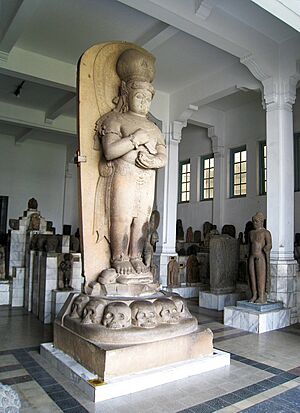
Majapahit's influence in Sumatra was shown by Adityawarman. He was a cousin of King Jayanegara and a senior minister. He led Majapahit's military expansion in Sumatra. He later founded the Pagaruyung Kingdom in Central Sumatra.
In later years, Majapahit's control over distant lands weakened. The Bruneian Empire and the Malacca Sultanate grew stronger. Malacca, in particular, became a rival to Majapahit for control of the Malacca Strait. However, the two kingdoms also had strong trade and cultural ties.
Majapahit's biggest rival was the powerful Ming dynasty of China. The Ming emperors wanted to show their power in Southeast Asia. After Majapahit was weakened by civil war, the arrival of Zheng He's large fleets reduced Majapahit's power. The Ming actively supported Malacca, which further weakened Majapahit's influence.
Majapahit's final challenge came from the Demak Sultanate in Java. Ming support for Malacca and the spread of Islam helped Muslim traders grow powerful in Java's coastal cities. This slowly weakened the Hindu-Buddhist kingship of Majapahit, leading to its fall.
Majapahit's Lasting Legacy
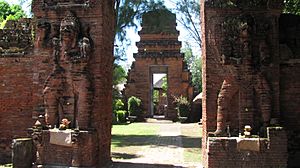
Majapahit was the largest empire ever in Southeast Asia. Its capital was a busy place where art and literature thrived.
Many local legends and folk tales mention Majapahit. From Aceh to Bali, stories tell of Javanese forces arriving in their lands. This shows how far the empire's influence reached.
Several Javanese legends became popular during the Majapahit period. These include the Panji cycles, the tale of Sri Tanjung, and the epic of Damarwulan. These stories are still popular in Javanese and Balinese culture. They inspire wayang (shadow puppet plays) and dance dramas.
Majapahit had a huge impact on Indonesian art and architecture. Its expansion spread Javanese culture throughout the archipelago. This is why you see Javanese cultural elements like gamelan music and the keris dagger on other islands.
The architecture of Majapahit, with its terracotta and red brick buildings, influenced Java and Bali. The candi bentar split gate and paduraksa towering gate are common features in Javanese and Balinese buildings today.
The rich Balinese culture is considered a legacy of Majapahit. Many Majapahit nobles, artists, and priests fled to Bali after the empire fell. They preserved ancient Hindu Javanese civilization there. Many Majapahit manuscripts are kept in Bali, providing valuable historical records.
The Majapahit expansion also helped spread the use of the keris dagger throughout Southeast Asia. The famous Malay legend of Kris Taming Sari also has Majapahit origins.
For Indonesians today, Majapahit is a symbol of past greatness. Modern Indonesian leaders, like Sukarno, used Majapahit to argue for a unified Indonesia. The Indonesian national motto, "Bhinneka Tunggal Ika", comes from a Majapahit poem. The Indonesian national symbol, the Garuda Pancasila, also has roots in Javanese Hindu traditions.
The Palapa series of Indonesian communication satellites is named after Gajah Mada's famous Palapa oath. This shows how Majapahit's legacy continues to inspire modern Indonesia.
Who Ruled Majapahit?
The rulers of Majapahit were part of the Rajasa dynasty, which started with Ken Arok in the 13th century.
| Years Ruled | Monarch | Capital City | Important Events |
|---|---|---|---|
| 1293–1309 | Raden Wijaya, also known as Kretarajasa Jayawardhana | Trowulan | Defeated the Mongol forces.
Became king on November 10, 1293. Faced rebellions, like Ranggalawe's (1295). |
| 1309–1328 | Kalagemet, also known as Jayanagara | Trowulan | Dealt with Nambi rebellion (1316) and Kuti rebellion (1319).
Murdered by his physician (1328). |
| 1328–1350 | Queen Sri Gitarja, also known as Tribhuwana Wijayatunggadewi | Trowulan | Dealt with Sadeng and Keta rebellions (1331).
Conquered Bali (1342–1343). Conquered Samudra Pasai (1349–1350). |
| 1350–1389 | Hayam Wuruk, also known as Sri Rajasanagara | Trowulan | The Pasunda Bubat incident (1357).
Majapahit's golden age, described in Nagarakretagama (1365). Attacked Palembang rebellion (1377). |
| 1389–1429 | Wikramawardhana, also known as Bhra Hyang Wisesa Aji Wikrama | Trowulan | Attacked Singapura (1398).
Won the Paregreg civil war against Bhre Wirabhumi (1405–1406). Campaign against Pagarruyung (1409). |
| 1429–1447 | Queen Suhita | Trowulan | |
| 1447–1451 | Kertawijaya | Trowulan | |
| 1451–1453 | Rajasawardhana | Trowulan | |
| 1453–1456 | No King | ||
| 1456–1466 | Girishawardhana | Trowulan | |
| 1466–1474 | Suraprabhawa | Trowulan (later moved to Daha) | Kertabhumi took over the capital (1468). |
| 1474–1498 | Girindrawardhana | Daha | Defeated Kertabhumi in the Sudarma Wisuta war (1478), ending Trowulan's rule. |
Images for kids
-
Cropped portion of China Sea in the Miller atlas, showing six and three-masted jong.
-
Deity holding a cuirass, from earlier, 10-11th century Nganjuk, East Java.
-
14th-century gold armlets and rings in Majapahit style, found in Singapore.
-
A 1.79 kilogram gold image discovered in Agusan, Philippines, showing Majapahit cultural influence.
-
High reliefs of Gajah Mada and Majapahit history depicted in Monas.
See also
 In Spanish: Imperio mayapajit para niños
In Spanish: Imperio mayapajit para niños




